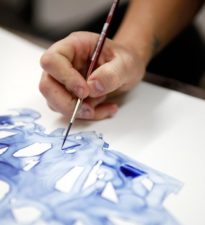
Lia Halloran
American, 1977-
The Magellanic Cloud, after Henrietta Swan Leavitt, 2016
Ink on drafting film
76 x 76 in.
Courtesy Lia Halloran Studio

Lia Halloran, undated photo, Chapman University
"I find it exciting to watch someone figure out an artwork or talk about what art does and can do, and offer a new way to understand seeing." - Lia Halloran

Lia Halloran in her studio
COMMENTS
"Your Body is a Space That Sees" is a series of large-scale cyanotype works (approximately 6ft x 6ft) that source the fragmented history and contributions of women in astronomy to represent a female-centric astronomical catalog of craters, comets, galaxies and nebula drawing from narrative, imagery and historical accounts of a group of women known as ‘Pickering’s Harem’ or the ‘Harvard Computers’. This little-known group of up to forty women made significant influences in the field of astronomy by setting up classification systems that are still used today to measure the distance, heat and chemical content of stars and yet were paid less than half the wages of men. Harvard University houses the largest collection of astronomical glass plates in the world – over 500,000 including the very first daguerreotype every taken of the moon. Research for this series was done in partnership with the archive to identify specific plates that were studied and used by the women in the ‘Harvard Computer’ group and these plates serve as a reference for large paintings of the galaxies or stellar objects within the plate. Your Body is a Space That Sees will offer an experience of the night sky through the discoveries made by these astronomers.
The cyanotypes works are created using a painting of a galaxy or stellar image on semi-transparent drafting film then pressed over paper that has been coated with light sensitive emulsion and exposed in the sun. The resulting piece is cyanotype print of the positive image in equal scale to its matching negative created without the utilization of a camera. This process mimics early astronomical glass plates moving between transparent surfaces and is multi-layered in meaning and technique: images of stars created by a star (our sun), paintings used to create a painting (light sensitive emulsion painted out and exposed by another painting). This is an expansion of a previous series titled Deep Sky Companion, which reinterprets the 18th Century French comet hunter Charles Messier’s Catalogue of Deep Sky Objects in 110 paintings and 110 photographic twins and is currently on view at Caltech’s Cahill Center for Astronomy and Astrophysics through December 18th, 2016. Cliché Verre was a process used by French painters such as such as Carot, Millet and Daubigny in the early 19th century as a method of making a photograph by painting on glass as the negative.
Artist Lia Halloran is an artist who grew up surfing and skateboarding in the Bay Area and developed a love of science during high school, in her first job, at the Exploratorium in San Francisco doing cow eye dissections and laser demonstrations. Her studio practice has been in dialogue with interactions science and nature for the past fifteen years and is the primary mediator between subject matter. Halloran’s work often makes use of scientific concepts as a starting point that interweave concepts of about sexuality, intimacy and physical movement to produce merged projects that have included astrophysics, magnetism, perception, scale, gravity, giant caves of crystals and ice, cabinets of curiosities, taxonomy, classification, periodic table of elements, skateboarding, and interconnections within the above. Halloran has participated in several interdisciplinary projects with scientists, artists, and architects including an upcoming book with working on a book with physicist Kip Thorne about the warped side of the universe with Kip’s poetry and her paintings.
- Copyright 2019 Schneider Museum of Art
https://sma.sou.edu/exhibitions/your-body-is-a-space-that-sees/
“Well, we met at a party, and I discovered that Lia was an artist, a fabulous artist, whose father was a physicist and so she actually speaks the language of physics and we could communicate …” Thorne began, but Halloran took the story over with - “Yeah, my favorite part about meeting Kip at this party was that he said to me that there was a young filmmaker who was interested in making a film that engaged some of his science and he needed someone to help visualize some of the strangeness of the universe, and that young filmmaker was Spielberg.”
Kip continued, “So I needed someone who could make drawings and paintings of black holes and wormholes to convey the ideas that would be in this film, and Lia helped me out. It was about 2006. The movie did finally become 'Interstellar' and it was eventually directed by Christopher Nolan.”
- excerpted from Teresa Miller Archer, Interview with Kip Thorne and Lia Halloran, Sept. 2016
SBMA CURATORIAL LABELS
L.A.-based artist and astrophysics enthusiast Lia Halloran often incorporates scientific principles and new media technologies into her practice. For her series “Your Body is a Space That Sees”, Halloran chose imagery that pays long overdue homage to the contributions of female astronomers since antiquity, including the Magellanic Cloud which led Henrietta Swan Leavitt to discover a method for measuring the distance between celestial bodies, a revelation that would later allow Edwin Hubble to prove that the universe is expanding.
To create these stunning cyanotypes, Halloran painted representations of celestial bodies onto transparent film and laid the film over photosensitive paper which was then exposed to direct sunlight. This cameraless process mimics the glass plate methods of early astrophotography and cleverly harnesses the power of the largest star of our solar system (the sun) to generate a representation of other stars.
- The Observable Universe: Visualizing the Cosmos in Art, 2019
